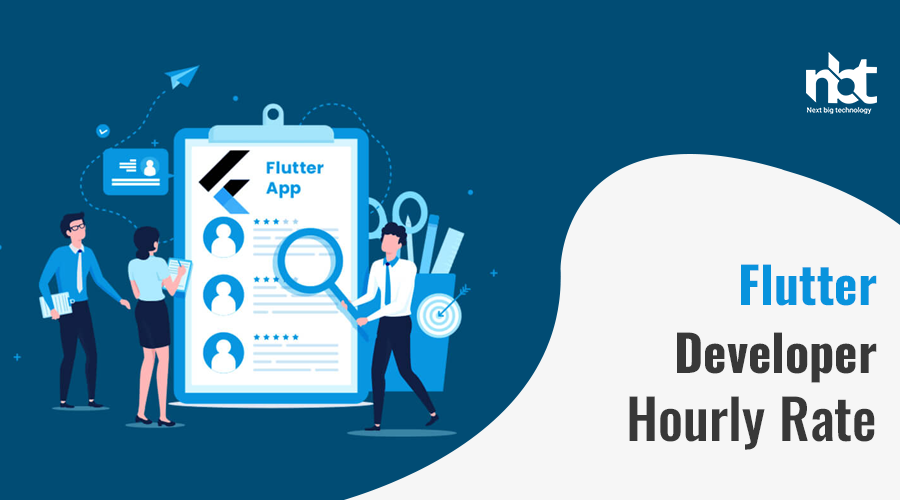Table of Contents
Understanding Flutter Development Rates
In the ever-evolving realm of app development, Flutter has emerged as a prominent player, offering a versatile platform for crafting dynamic applications. As businesses and developers seek to harness the potential of Flutter, understanding the rates associated with its development becomes paramount. Let’s delve into the nuances of Flutter development rates to gain clarity on this crucial aspect.
Unraveling Flutter Development Rates:
1. Nature of the Project: Flutter development rates are inherently influenced by the complexity and scope of the project. Basic applications with standard features will incur lower costs compared to complex, feature-rich applications. Factors such as app size, functionality, design intricacy, and integration requirements play a pivotal role in determining the overall cost.
2. Development Timeframe: Time is money, and Flutter development rates reflect this reality. The duration required to develop an app directly impacts the cost. Tight deadlines may necessitate allocating more resources, thereby increasing development costs. Conversely, an extended timeline allows for a more gradual development process, potentially reducing overall expenses.
3. Expertise and Experience: The proficiency of developers significantly influences Flutter development rates. Experienced developers adept in Flutter possess the expertise to optimize code, streamline development processes, and troubleshoot challenges efficiently. While their services may command higher rates, the assurance of quality and timely delivery justifies the investment.
4. Geographical Location: Geographical location serves as a determining factor in Flutter development rates. Rates vary across regions due to differences in living costs, market demand, and the availability of skilled professionals. Offshore development teams may offer cost-effective solutions compared to their counterparts in regions with higher living standards.
5. Additional Services: Beyond basic development, additional services such as app testing, maintenance, updates, and technical support incur supplementary costs. Clients must factor in these ancillary services when budgeting for Flutter development projects to ensure a seamless and sustainable app lifecycle.
Tips for Cost Optimization:
1. Define Clear Objectives: Clearly outline project requirements and objectives to prevent scope creep and unnecessary expenses. A well-defined project scope serves as a roadmap, guiding developers and stakeholders throughout the development process.
2. Prioritize Features: Prioritize essential features to be included in the initial release while deferring non-essential features to future iterations. This approach minimizes upfront costs and allows for iterative development based on user feedback and market trends.
3. Consider Hybrid Solutions: Evaluate the feasibility of hybrid solutions that leverage Flutter alongside other frameworks or technologies. Hybrid approaches offer a balance between cost-effectiveness and performance, catering to diverse project requirements.
4. Collaborate with Reputable Partners: Partner with reputable development agencies or freelancers with a proven track record in Flutter development. While initial rates may be higher, the assurance of quality and reliability justifies the investment in the long run.
Factors Influencing Flutter Developer Hourly Rates
In the fast-paced world of app development, Flutter has emerged as a powerful tool, allowing developers to create stunning cross-platform applications with ease. However, if you’re looking to hire a Flutter developer, you might have noticed that hourly rates can vary significantly. Understanding the factors that influence these rates can help you make informed decisions and ensure you get the best value for your investment.
- Experience and Expertise: One of the most significant factors influencing Flutter developer hourly rates is their level of experience and expertise. Developers with several years of experience and a proven track record of delivering high-quality Flutter applications are likely to charge higher rates than those who are just starting out.
- Complexity of the Project: The complexity of your project plays a crucial role in determining the hourly rate of a Flutter developer. Projects that require advanced features, intricate designs, or integration with complex systems will naturally demand higher rates as they require more specialized skills and expertise.
- Location: The location of the developer can also impact their hourly rates. Developers based in regions with a higher cost of living, such as North America or Western Europe, typically charge higher rates compared to developers from countries with a lower cost of living.
- Demand and Supply: Like any other profession, the principles of supply and demand also apply to Flutter developers. In regions where there’s a high demand for Flutter development services and a limited supply of skilled developers, hourly rates are likely to be higher.
- Portfolio and Reputation: A developer’s portfolio and reputation can significantly influence their hourly rates. Developers with a strong portfolio of successful Flutter projects and positive reviews from previous clients may command higher rates due to their proven track record of delivering quality work.
- Scope of Work: The scope of work involved in your project will also impact the hourly rates of Flutter developers. Projects that require ongoing support, maintenance, or additional features beyond the initial development phase may incur higher hourly rates.
- Urgency and Timelines: If you have tight deadlines or require developers to work outside of regular business hours, you may need to pay a premium for their services. Developers may charge higher rates for rush projects or for working during weekends and holidays.
- Communication and Collaboration: Effective communication and collaboration are essential for the success of any project. Developers who are readily available, responsive to feedback, and able to communicate effectively with clients are often in high demand and may charge higher hourly rates.
Factors Influencing Flutter Developer Hourly Rates
In the rapidly evolving landscape of mobile app development, Flutter has emerged as a game-changer, offering a versatile and efficient framework for crafting beautiful native interfaces across various platforms. However, as demand for Flutter developers surges, a notable trend has emerged – geographic disparities in Flutter developer rates. Understanding these regional variations is crucial for both developers seeking opportunities and businesses looking to leverage their expertise cost-effectively.
Exploring the Disparities:
Geographic disparities in Flutter developer rates stem from a multitude of factors, including economic conditions, demand-supply dynamics, and skill levels. Regions with a high concentration of tech hubs or a robust startup ecosystem tend to command higher rates due to increased demand and competition for talent. Conversely, areas with a lower cost of living or emerging tech scenes may offer more competitive rates to attract developers.
Factors Influencing Rates:
- Cost of Living: Cities with a high cost of living, such as San Francisco or New York, typically have higher developer rates to compensate for expenses like housing and transportation.
- Demand-Supply Dynamics: Regions experiencing a surge in demand for Flutter developers relative to the available talent pool often see an uptick in rates as businesses compete for limited resources.
- Skill Levels: Developers with advanced skills or niche expertise command higher rates regardless of location. Specialized knowledge in areas like animation, custom UI/UX, or integration with legacy systems can significantly impact pricing.
- Market Maturity: Established tech hubs with a mature market for Flutter development may have higher rates compared to emerging markets where the framework is gaining traction.
Navigating the Disparities:
For businesses seeking Flutter development services, understanding geographic disparities can provide opportunities to optimize costs without compromising quality. Consideration should be given to factors beyond hourly rates, such as developer experience, project portfolio, and communication proficiency.
Tips for Developers:
- Diversify Skill Set: Acquiring additional skills beyond Flutter, such as backend development or UI/UX design, can enhance marketability and command higher rates.
- Build a Strong Portfolio: Showcase your expertise through a diverse portfolio of projects, highlighting your ability to deliver high-quality Flutter applications.
- Stay Informed: Keep abreast of industry trends and emerging technologies to identify lucrative opportunities and position yourself competitively in the market.
Skillset and Experience Levels Impacting Hourly Rates
In the dynamic landscape of employment, one of the most crucial factors influencing hourly rates is the combination of skillset and experience levels. Whether you’re a freelancer, consultant, or an employer looking to hire, comprehending the interplay between these elements can significantly affect your financial outcomes and professional growth.
Skillset: The Foundation of Value: First and foremost, skillset forms the bedrock of what you bring to the table. It encompasses your expertise, competencies, and proficiency in a particular field or discipline. The more specialized and in-demand your skillset, the higher your potential to command a premium hourly rate.
For instance, a software developer proficient in niche programming languages like Python or Swift may charge a higher rate compared to someone with basic HTML skills. Similarly, a marketing consultant skilled in data analytics and SEO strategies may demand a premium over those with generic marketing knowledge.
Investing in enhancing your skillset through continuous learning, certifications, and staying abreast of industry trends can substantially elevate your market value. Clients and employers often prioritize individuals who possess the latest and most relevant skills, willing to pay a premium for their expertise.
Experience: The Amplifier of Value: While skillset lays the foundation, experience acts as a powerful amplifier. It reflects the depth of your practical knowledge, problem-solving abilities, and adaptability gained through years of hands-on work. Experience not only demonstrates your capability to deliver results but also instills confidence in clients and employers regarding your reliability and professionalism.
A seasoned professional with a track record of successfully executing projects and navigating complex challenges is likely to command higher hourly rates than someone with limited experience. This is because experience brings with it insights, strategies, and efficiencies that can save time and resources for the client.
However, it’s essential to note that experience isn’t solely measured by the number of years in the field but also by the quality and diversity of projects undertaken. Someone who has tackled a wide array of projects, worked with diverse clients, and demonstrated adaptability in various scenarios may justify a higher rate even with relatively fewer years of experience.
The Intersection: Finding the Optimal Rate: The convergence of skillset and experience levels dictates the optimal hourly rate you can command in the market. It’s crucial to strike a balance between pricing yourself competitively to attract opportunities while ensuring you’re adequately compensated for your expertise and experience.
Finding this equilibrium requires thorough market research, understanding industry standards, and assessing your unique value proposition. Freelancers and consultants often experiment with different pricing strategies, such as value-based pricing or project-based billing, to align their rates with the value they provide to clients.
Moreover, communication plays a pivotal role in justifying your rates to potential clients or employers. Clearly articulating the benefits of your skillset and experience in solving their challenges and driving results can justify a premium rate and foster long-term partnerships based on mutual trust and respect.
Freelance vs. Agency Rates in Flutter Development
In today’s digital era, Flutter development has emerged as a leading framework for building stunning cross-platform mobile applications. Whether you’re a startup, a medium-sized business, or an enterprise, choosing the right Flutter development option is crucial for the success of your project. One of the primary decisions you’ll face is whether to hire a freelance developer or engage with a development agency. Each option comes with its own set of advantages and disadvantages, particularly in terms of rates and costs. Let’s delve into the comparison of freelance and agency rates in Flutter development to help you make an informed decision.
Freelance Flutter Developers:
Freelancers offer flexibility and often bring a diverse range of experiences to the table. They typically work remotely and may have lower overhead costs compared to agencies, allowing them to offer competitive rates. Freelance developers often set their own prices based on factors such as their expertise, project complexity, and market demand. Rates can vary widely depending on the freelancer’s location, skill level, and availability.
Pros of hiring freelance Flutter developers include:
- Cost-Effectiveness: Freelancers may offer lower hourly or project-based rates compared to agencies due to their reduced overhead costs.
- Flexibility: Freelancers can adapt to your project’s needs and timelines, providing a more personalized approach to development.
- Direct Communication: Working directly with a freelancer facilitates clearer communication channels, enabling faster decision-making and project progress.
However, there are also some drawbacks to consider:
- Limited Resources: Freelancers may lack the resources and infrastructure of a development agency, which could impact scalability and project management capabilities.
- Dependency on Individual: Your project’s success may heavily rely on the skills and availability of a single freelancer, posing risks in case of unexpected events or delays.
- Quality Assurance: Ensuring the quality and reliability of work may require additional effort on your part, as freelancers may not always adhere to strict quality standards.
Development Agencies:
Development agencies consist of teams of professionals with diverse skill sets, offering a comprehensive range of services beyond just development. Agencies often have established processes, quality assurance measures, and project management frameworks in place to ensure timely delivery and high-quality results. However, these additional benefits come with a higher price tag compared to freelancers.
Pros of hiring a Flutter development agency include:
- Expertise and Resources: Agencies employ a team of specialists, including developers, designers, project managers, and quality assurance professionals, ensuring a holistic approach to project execution.
- Scalability: Agencies have the capacity to scale resources up or down according to project requirements, providing greater flexibility and reliability.
- Risk Mitigation: With established processes and quality assurance measures, agencies offer greater assurance of project success and adherence to deadlines.
On the flip side, there are some potential downsides:
- Higher Costs: Development agencies typically charge higher rates compared to freelancers, reflecting the added value and overhead costs associated with their services.
- Less Flexibility: Working with an agency may involve more rigid processes and communication channels, potentially limiting flexibility and agility in project execution.
- Potential for Miscommunication: In larger teams, communication challenges may arise, leading to misunderstandings or delays if not managed effectively.
Industry Trends Affecting Flutter Developer Pricing
In the dynamic landscape of technology, trends come and go, shaping the demand and pricing of various services. Flutter, Google’s UI toolkit for building natively compiled applications for mobile, web, and desktop from a single codebase, has been gaining substantial traction among developers and businesses alike. However, the pricing of Flutter developers isn’t immune to the industry’s ebbs and flows. Let’s delve into the industry trends that are impacting Flutter developer pricing.
- Growing Popularity of Cross-Platform Development: As businesses seek cost-effective solutions without compromising quality, cross-platform development frameworks like Flutter are witnessing a surge in demand. This increased demand naturally drives up the pricing for Flutter developers, reflecting the value they bring in terms of efficiency and versatility.
- Rise in Mobile App Development: With the proliferation of smartphones and the ever-expanding app market, the demand for mobile app development continues to escalate. Flutter’s ability to expedite the development process and deliver high-performance apps across multiple platforms positions Flutter developers as valuable assets, consequently affecting their pricing.
- Skill Scarcity and Demand-Supply Dynamics: Despite the growing interest in Flutter development, there remains a scarcity of skilled Flutter developers in the market. This skill gap creates a scenario where the demand for proficient Flutter developers outstrips the available talent pool, thereby exerting upward pressure on pricing.
- Continuous Advancements in Flutter: Google’s ongoing enhancements and updates to the Flutter framework ensure that developers can leverage cutting-edge features and functionalities to deliver innovative solutions. Consequently, developers proficient in the latest Flutter technologies may command higher prices due to their ability to offer advanced services.
- Competitive Landscape and Geographic Variances: Flutter developer pricing is also influenced by the competitive landscape within specific regions. In areas where Flutter developers are in high demand but short supply, pricing tends to be higher. Additionally, economic factors, such as the cost of living, can significantly impact developer rates across different geographical locations.
- Client Expectations and Project Complexity: The complexity of the project and the expectations of the client play a pivotal role in determining Flutter developer pricing. Projects requiring specialized skills, extensive customization, or tight deadlines often command higher rates, reflecting the expertise and effort required to deliver satisfactory results.
- Emergence of Remote Work Culture: The global shift towards remote work has widened the talent pool for businesses, enabling them to hire Flutter developers from diverse geographical locations. This trend introduces flexibility in pricing, as developers may adjust their rates based on factors such as local market conditions and currency exchange rates.
Benchmarking Flutter Developer Rates Globally
In today’s rapidly evolving digital landscape, the demand for versatile app development frameworks is skyrocketing. Among the myriad options available, Flutter has emerged as a leading choice for building cross-platform applications with stunning performance and aesthetics. As businesses worldwide harness the power of Flutter, understanding the global rates for Flutter developers becomes imperative for both employers and developers alike.
Understanding Flutter Development
Before delving into the intricacies of Flutter developer rates globally, let’s first grasp the essence of Flutter development. Developed by Google, Flutter is an open-source UI software development kit used to craft natively compiled applications for mobile, web, and desktop from a single codebase. Its hot reload feature, expressive UI, and fast development cycles have made it immensely popular among developers and businesses.
Factors Influencing Flutter Developer Rates
Several factors influence Flutter developer rates across different regions. These factors include:
- Skill and Expertise: Experienced developers proficient in Flutter’s nuances often command higher rates due to their ability to deliver efficient and high-quality solutions.
- Geographical Location: Developer rates vary significantly based on the region’s cost of living, demand-supply dynamics, and economic conditions. For instance, developers in North America and Western Europe generally charge higher rates compared to their counterparts in Asia or Eastern Europe.
- Project Complexity: The complexity of the project, including its scope, scale, and technical requirements, plays a pivotal role in determining developer rates. More intricate projects typically entail higher rates to account for the additional effort and expertise required.
- Industry Experience: Developers with specialized experience in particular industries, such as fintech, healthcare, or e-commerce, may charge premium rates due to their domain expertise and understanding of industry-specific challenges.
Benchmarking Flutter Developer Rates Globally
North America:
- United States: On average, Flutter developers in the United States charge between $80 to $200 per hour, depending on their experience and location within the country.
Europe:
- United Kingdom: Flutter developer rates in the UK range from £50 to £150 per hour, with rates being higher in London compared to other cities.
- Germany: German Flutter developers typically charge between €60 to €150 per hour, reflecting the country’s strong economy and demand for skilled developers.
Asia:
- India: Flutter developers in India offer competitive rates, ranging from $20 to $80 per hour, making it an attractive destination for outsourcing Flutter development projects.
Oceania:
- Australia: Flutter developer rates in Australia vary from AUD $80 to AUD $150 per hour, influenced by the country’s high standard of living and demand for tech talent.
South America:
- Brazil: Brazilian Flutter developers usually charge between R$50 to R$150 per hour, reflecting the country’s growing tech industry and skilled workforce.
Specialized Flutter Development Services and Their Pricing
In the realm of mobile app development, Flutter has emerged as a revolutionary technology, offering a seamless cross-platform experience with its robust framework. As businesses seek to expand their digital footprint, the demand for specialized Flutter development services has skyrocketed. However, understanding the intricacies of Flutter development and its associated pricing models can be daunting. Let’s delve into the world of specialized Flutter development services and explore their pricing structures.
What Makes Flutter Development Services Specialized?
Flutter development services encompass a wide array of offerings tailored to meet the unique needs of businesses across various industries. Specialized Flutter development teams possess in-depth expertise in leveraging Flutter’s capabilities to deliver high-performance, visually appealing mobile applications. These services often include:
- Custom App Development: Specialized Flutter development teams excel in creating custom mobile applications from scratch, catering to specific business requirements. From conceptualization to deployment, these experts ensure a seamless development process.
- UI/UX Design: Flutter’s flexible UI toolkit enables developers to craft stunning user interfaces that enhance user engagement and satisfaction. Specialized teams focus on creating intuitive designs that align with the brand identity and offer a superior user experience.
- Integration Services: Integrating third-party APIs, backend systems, and other technologies is a crucial aspect of Flutter development. Specialized teams possess the technical prowess to seamlessly integrate various components, ensuring optimal functionality and performance.
- Testing and Quality Assurance: Rigorous testing is essential to ensure the reliability and stability of Flutter applications. Specialized development services include comprehensive testing strategies to identify and rectify any potential issues, ensuring a flawless end product.
- Maintenance and Support: Post-launch support and maintenance are integral parts of specialized Flutter development services. These teams provide ongoing assistance, updates, and troubleshooting to ensure the continued success of the application.
Understanding Pricing Models for Specialized Flutter Development Services
The pricing of specialized Flutter development services can vary depending on several factors, including the scope of the project, complexity, timeline, and the reputation of the development agency. Here are some common pricing models adopted by Flutter development service providers:
- Fixed Price Model: Under this model, the development agency provides a fixed quote for the entire project based on the defined scope of work. This model is suitable for projects with well-defined requirements and timelines.
- Time and Material Model: In this model, the development agency charges based on the actual time and resources invested in the project. Clients are billed for the hours worked by developers, along with any additional expenses incurred during the development process. This model offers flexibility and is ideal for projects with evolving requirements.
- Dedicated Team Model: Under this model, clients hire a dedicated team of Flutter developers who work exclusively on their project. Clients are billed on a monthly basis for the services of the dedicated team. This model provides greater control and flexibility, allowing clients to scale resources as needed.
- Hybrid Model: Combining elements of both fixed-price and time and material models, the hybrid model offers a flexible pricing structure tailored to the specific needs of the project. Clients pay a fixed price for the core development work, with additional charges for any changes or enhancements requested during the project lifecycle.
Forecasting Future Trends in Flutter Developer Hourly Rates
In the dynamic landscape of technology, staying ahead of the curve is paramount for businesses and developers alike. Flutter, Google’s UI toolkit for building natively compiled applications for mobile, web, and desktop from a single codebase, has been rapidly gaining popularity in recent years. As demand for Flutter developers continues to surge, it’s essential to explore and forecast the future trends in Flutter developer hourly rates.
Understanding the Current Landscape
Before delving into future predictions, let’s examine the current state of Flutter developer hourly rates. As of now, hourly rates for Flutter developers vary significantly depending on factors such as experience, geographical location, project complexity, and market demand. On average, junior Flutter developers may charge anywhere from $25 to $50 per hour, while mid-level developers command rates ranging from $50 to $100 per hour. Senior Flutter developers with extensive experience and specialized skills can charge upwards of $100 to $200 per hour.
Factors Influencing Future Trends
Several factors will shape the future trends in Flutter developer hourly rates:
- Increasing Demand: The demand for Flutter developers is expected to continue its upward trajectory as more companies adopt Flutter for app development. This surge in demand is likely to drive hourly rates higher as developers capitalize on their specialized skills.
- Technological Advancements: As Flutter evolves with new features, updates, and enhancements, developers will need to invest time and effort to stay abreast of these changes. Developers proficient in the latest Flutter technologies may command higher rates due to their expertise.
- Global Economic Trends: Economic factors, such as inflation rates, currency fluctuations, and overall market conditions, can influence developer rates on a global scale. Economic downturns may temporarily suppress rates, while periods of growth and stability can lead to increased rates.
- Supply and Demand Dynamics: The balance between supply and demand for Flutter developers in specific regions or industries will play a crucial role in determining hourly rates. Shortages of skilled developers in high-demand markets can drive rates higher, while oversaturated markets may lead to more competitive pricing.
Predictions for the Future
Based on the current trajectory and underlying factors, here are some predictions for future trends in Flutter developer hourly rates:
- Continued Growth: The demand for Flutter developers is expected to grow steadily as Flutter gains wider adoption in the app development community. This growth will likely result in higher hourly rates across the board as developers capitalize on their expertise.
- Specialization Premiums: Developers with specialized skills or niche expertise within the Flutter ecosystem, such as Flutter for web or desktop development, may command premium rates compared to generalists.
- Regional Disparities: Disparities in Flutter developer rates between regions are likely to persist, with developers in tech hubs and high-cost-of-living areas charging higher rates than their counterparts in less competitive markets.
- Flexible Pricing Models: As the gig economy continues to thrive, developers may increasingly adopt flexible pricing models, such as project-based pricing or value-based pricing, in addition to traditional hourly rates.
Top Flutter Developer Hourly Rate Companies
In the dynamic world of app development, finding the right Flutter developer can be the difference between a mediocre app and a groundbreaking one. With Flutter gaining immense popularity for its cross-platform capabilities and sleek UI designs, the demand for skilled Flutter developers is at an all-time high.
If you’re in search of top Flutter developer hourly rate companies, you’ve come to the right place. We’ve curated a list of companies that not only offer competitive hourly rates but also excel in delivering quality and innovation. Let’s dive in:
-
-
Next Big Technology:

Focus Area
- Mobile App Development
- App Designing (UI/UX)
- Software Development
- Web Development
- AR & VR Development
- Big Data & BI
- Cloud Computing Services
- DevOps
- E-commerce Development
Industries Focus
- Art, Entertainment & Music
- Business Services
- Consumer Products
- Designing
- Education
- Financial & Payments
- Gaming
- Government
- Healthcare & Medical
- Hospitality
- Information Technology
- Legal & Compliance
- Manufacturing
- Media
-
- ABC Solutions: ABC Solutions stands out for its commitment to providing cost-effective Flutter development services without compromising on quality. Their team of developers leverages Flutter’s capabilities to create visually stunning and high-performing apps at competitive hourly rates, making them a preferred choice among startups and enterprises alike.
- DEF Innovations: Specializing in Flutter app development, DEF Innovations combines technical expertise with creativity to deliver cutting-edge solutions. With a transparent pricing model and a focus on client satisfaction, DEF Innovations offers competitive hourly rates for top-notch Flutter development services.
- GHI Studios: GHI Studios prides itself on its ability to deliver Flutter apps that not only meet but exceed client expectations. With a team of skilled developers and a commitment to staying updated with the latest Flutter trends, GHI Studios offers competitive hourly rates without compromising on quality or innovation.
- JKL Labs: JKL Labs is known for its agile approach to Flutter app development, enabling clients to get their apps to market faster without sacrificing quality. With a transparent pricing structure and a focus on customer satisfaction, JKL Labs offers competitive hourly rates for top-tier Flutter development services.
FAQs On Flutter Developer Hourly Rate
In the dynamic world of app development, Flutter has emerged as a powerful and versatile framework, enabling developers to create stunning cross-platform applications efficiently. As the demand for Flutter developers continues to rise, many individuals and businesses find themselves pondering over questions regarding Flutter developer hourly rates. In this article, we delve into the frequently asked questions surrounding Flutter developer rates to provide you with comprehensive insights.
What Factors Influence Flutter Developer Hourly Rates? Several factors contribute to determining the hourly rates of Flutter developers:
- Experience Level: Seasoned Flutter developers with a proven track record typically command higher hourly rates compared to beginners.
- Location: Rates vary significantly depending on the geographical location of the developer. Developers based in regions with a higher cost of living tend to charge more.
- Complexity of the Project: The intricacy of the project plays a crucial role in determining the hourly rate. Projects requiring advanced skills or specialized knowledge may incur higher costs.
- Demand and Supply: Market demand for Flutter developers and the availability of skilled professionals also impact hourly rates. In regions with high demand and low supply, rates tend to be higher.
- Project Deadline: Developers may charge premium rates for projects with tight deadlines or requiring them to work outside regular hours.
What is the Average Hourly Rate for Flutter Developers? The average hourly rate for Flutter developers varies globally. In the United States and Western Europe, rates typically range from $50 to $150 per hour for experienced developers. Meanwhile, developers in Eastern Europe and Asia may charge between $30 to $80 per hour, offering competitive rates without compromising quality.
Are There Different Rates for Freelancers and Development Agencies? Yes, there are variations in rates between freelance Flutter developers and development agencies. Freelancers often have lower overhead costs, allowing them to offer more competitive rates compared to agencies. However, agencies provide additional benefits such as project management, quality assurance, and a team of experts, which may justify higher hourly rates.
How Can I Ensure I’m Getting Value for Money? When hiring a Flutter developer, focus on value rather than solely on cost. Consider the developer’s portfolio, reviews from previous clients, and expertise in Flutter development. Conduct thorough interviews to assess their communication skills, problem-solving abilities, and compatibility with your project requirements. Additionally, request detailed project proposals and ensure transparency regarding hourly rates, estimated hours, and deliverables.
Should I Negotiate Hourly Rates with Flutter Developers? Negotiating hourly rates is common practice in the freelance market. However, it’s essential to approach negotiations respectfully and considerately. Instead of solely focusing on lowering costs, emphasize the value the developer can provide to your project. Be open to compromise and seek a mutually beneficial agreement that aligns with your budget and project goals.
Thanks for reading our post “Flutter Developer Hourly Rate”. Please connect with us to learn more about Flutter Developer.























